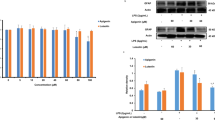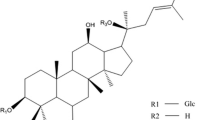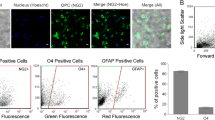Abstract
The glycosylated phenylpropanoid verbascoside (VB), isolated from cultured cells of the medicinal plant Syringa vulgaris (Oleaceae), has previously been characterized as an effective scavenger of biologically active free radicals and an inhibitor of lipid peroxidation. The aim of the present study was to evaluate in a rat glioma cell line (C6) the effect of VB biotechnologically produced by S. vulgaris plant cell cultures in the regulation of the inflammatory response. We used a model of central nervous system inflammation induced by bacterial endotoxin/cytokine (lipopolysaccharide (LPS)/interferon (IFN)-γ, 1 μg/ml and 100 U/ml, respectively). Our results show that the treatment with LPS/IFN-γ for 24 h elicited the induction of inducible nitric oxide synthase (iNOS) activity as determined by NO x accumulation in the culture medium. Preincubation with VB (10–100 μg/ml) abrogated the mixed cytokine-mediated induction of iNOS. The effect was concentration-dependent. Our studies also showed an inhibitory effect of VB on neuronal nitric oxide synthase expression. Moreover, Western blot analysis showed that this glycoside prevents specifically the activation of the proinflammatory enzyme cyclooxygenase (COX)-2 in glioma cells without simultaneous inhibition of COX-1 enzyme. Moreover, we found that VB reduced the expression of proinflammatory enzymes in LPS/IFN-γ through the inhibition of the activation of nuclear factor kappa B and mitogen-activated protein kinase signaling pathway. The mechanisms underlying in vitro the neuroprotective properties of VB involve modulation of transcription factors and consequent altered gene expression, resulting in downregulation of inflammation. These findings provide support that VB may provide a promising approach for the treatment of oxidative-stress-related neurodegenerative diseases.








Similar content being viewed by others
Abbreviations
- PPGs:
-
Phenylpropanoid glycosides
- PPs:
-
Phenylpropanoids
- VB:
-
Verbascoside
- NO:
-
Nitric oxide
- NOS:
-
Nitric oxide synthase
- CNS:
-
Central nervous system
- NF-κB:
-
Nuclear factor kappa B
- MAPKs:
-
Mitogen-activated protein kinases
- DMEM:
-
Dulbecco’s modified essential medium
- LPS:
-
Lipopolysaccharide
- IFN:
-
Interferon
- MDA:
-
Malondialdehyde
- COX:
-
Cyclooxygenase
References
Aggarwal BB (2004) Nuclear factor-kappa B: the enemy within. Cancer Cell 6:203–208
Ames BN, Shigenaga MK, Hagen TM (1993) Oxidants, antioxidants, and the degenerative diseases of aging. Proc Natl Acad Sci U S A 90:7915–7922
Aoki E, Semba R, Mikoshiba K, Kashiwamata S (1991) Predominant localization in glial cells of free l-arginine. Immunocytochemical evidence. Brain Res 547:190–192
Beal MF (2003) Bioenergetic approaches for neuroprotection in Parkinson’s disease. Ann Neurol 53(Suppl 3):S39–S47 discussion S47–38
Bissell MG, Rubinstein LJ, Bignami A, Herman MM (1974) Characteristics of the rat C-6 glioma maintained in organ culture systems. Production of glial fibrillary acidic protein in the absence of gliofibrillogenesis. Brain Res 82:77–89
Bolanos JP, Almeida A, Stewart V, Peuchen S, Land JM, Clark JB, Heales SJ (1997) Nitric oxide-mediated mitochondrial damage in the brain: mechanisms and implications for neurodegenerative diseases. J Neurochem 68:2227–2240
Brambilla R, Neary JT, Cattabeni F, Cottini L, D'Ippolito G, Schiller PC, Abbracchio MP (2002) Induction of COX-2 and reactive gliosis by P2Y receptors in rat cortical astrocytes is dependent on ERK1/2 but independent of calcium signalling. J Neurochem 83:1285–1296
Bredt DS, Snyder SH (1990) Isolation of nitric oxide synthetase, a calmodulin-requiring enzyme. Proc Natl Acad Sci U S A 87:682–685
Calabrese V, Scapagnini G, Giuffrida Stella AM, Bates TE, Clark JB (2001) Mitochondrial involvement in brain function and dysfunction: relevance to aging, neurodegenerative disorders and longevity. Neurochem Res 26:739–764
Calabrese V, Boyd-Kimball D, Scapagnini G, Butterfield DA (2004) Nitric oxide and cellular stress response in brain aging and neurodegenerative disorders: the role of vitagenes. In Vivo 18:245–267
Cieslik K, Zhu Y, Wu KK (2002) Salicylate suppresses macrophage nitric-oxide synthase-2 and cyclo-oxygenase-2 expression by inhibiting CCAAT/enhancer-binding protein-beta binding via a common signaling pathway. J Biol Chem 277:49304–49310
Dawson VL, Dawson TM (1996) Nitric oxide neurotoxicity. J Chem Neuroanat 10:179–190
de Vera ME, Shapiro RA, Nussler AK, Mudgett JS, Simmons RL, Morris SM Jr, Billiar TR, Geller DA (1996) Transcriptional regulation of human inducible nitric oxide synthase (NOS2) gene by cytokines: initial analysis of the human NOS2 promoter. Proc Natl Acad Sci U S A 93:1054–1059
Delacourte A (1990) General and dramatic glial reaction in Alzheimer brains. Neurology 40:33–37
Dexter DT, Carter CJ, Wells FR, Javoy-Agid F, Agid Y, Lees A, Jenner P, Marsden CD (1989) Basal lipid peroxidation in substantia nigra is increased in Parkinson’s disease. J Neurochem 52:381–389
Dignam JD, Lebovitz RM, Roeder RG (1983) Accurate transcription initiation by RNA polymerase II in a soluble extract from isolated mammalian nuclei. Nucleic Acids Res 11:1475–1489
Eddleston M, Mucke L (1993) Molecular profile of reactive astrocytes—implications for their role in neurologic disease. Neuroscience 54:15–36
Emerit J, Edeas M, Bricaire F (2004) Neurodegenerative diseases and oxidative stress. Biomed Pharmacother 58:39–46
Endoh M, Maiese K, Wagner J (1994) Expression of the inducible form of nitric oxide synthase by reactive astrocytes after transient global ischemia. Brain Res 651:92–100
Ennamany R, Marzetto S, Saboureau D, Creppy EE (1995) Lipid peroxidation induced by bolesatine, a toxin of Boletus satanas: implication in m5dC variation in Vero cells related to inhibition of cell growth. Cell Biol Toxicol 11:347–354
Galea E, Reis DJ, Feinstein DL (1994) Cloning and expression of inducible nitric oxide synthase from rat astrocytes. J Neurosci Res 37:406–414
Gegg ME, Beltran B, Salas-Pino S, Bolanos JP, Clark JB, Moncada S, Heales SJ (2003) Differential effect of nitric oxide on glutathione metabolism and mitochondrial function in astrocytes and neurones: implications for neuroprotection/neurodegeneration? J Neurochem 86:228–237
Gilmore TD (1999) The Rel/NF-kappa B signal transduction pathway: introduction. Oncogene 18:6842–6844
Haddad JJ (2004) Oxygen sensing and oxidant/redox-related pathways. Biochem Biophys Res Commun 316:969–977
Hsu S (2005) Green tea and the skin. J Am Acad Dermatol 52:1049–1059
Ito CY, Kazantsev AG, Baldwin AS Jr (1994) Three NF-kappa B sites in the I kappa B-alpha promoter are required for induction of gene expression by TNF alpha. Nucleic Acids Res 22:3787–3792
Kelleher ZT, Matsumoto A, Stamler JS, Marshall HE (2007) NOS2 regulation of NF-kappaB by S-nitrosylation of p65. J Biol Chem 282:30667–30672
Korkina LG (2007) Phenylpropanoids as naturally occurring antioxidants: from plant defense to human health. Cell Mol Biol 53:15–25
Korkina LG, Mikhal’chik E, Suprun MV, Pastore S, Dal Toso R (2007) Molecular mechanisms underlying wound healing and anti-inflammatory properties of naturally occurring biotechnologically produced phenylpropanoid glycosides. Cell Mol Biol 53:84–91
Kris-Etherton PM, Hecker KD, Bonanome A, Coval SM, Binkoski AE, Hilpert KF, Griel AE, Etherton TD (2002) Bioactive compounds in foods: their role in the prevention of cardiovascular disease and cancer. Am J Med 113(Suppl 9B):71S–88S
Lee JK, Choi SS, Won JS, Suh HW (2003) The regulation of inducible nitric oxide synthase gene expression induced by lipopolysaccharide and tumor necrosis factor-alpha in C6 cells: involvement of AP-1 and NFkappaB. Life Sci 73:595–609
Lee JY, Woo ER, Kang KW (2005) Inhibition of lipopolysaccharide-inducible nitric oxide synthase expression by acteoside through blocking of AP-1 activation. J Ethnopharmacol 97:561–566
Lin LC, Wang YH, Hou YC, Chang S, Liou KT, Chou YC, Wang WY, Shen YC (2006) The inhibitory effect of phenylpropanoid glycosides and iridoid glucosides on free radical production and beta2 integrin expression in human leucocytes. J Pharm Pharmacol 58:129–135
Lowenstein CJ, Alley EW, Raval P, Snowman AM, Snyder SH, Russell SW, Murphy WJ (1993) Macrophage nitric oxide synthase gene: two upstream regions mediate induction by interferon gamma and lipopolysaccharide. Proc Natl Acad Sci U S A 90:9730–9734
Lyras L, Cairns NJ, Jenner A, Jenner P, Halliwell B (1997) An assessment of oxidative damage to proteins, lipids, and DNA in brain from patients with Alzheimer’s disease. J Neurochem 68:2061–2069
Marchetti B (1997) Cross-talk signals in the CNS: role of neurotrophic and hormonal factors, adhesion molecules and intercellular signaling agents in luteinizing hormone-releasing hormone (LHRH)-astroglial interactive network. Front Biosci 2:88–125
Matkowski A (2008) Plant in vitro culture for the production of antioxidants—a review. Biotechnol Adv 26:548–560
Mattace Raso G, Esposito E, Iacono A, Pacilio M, Coppola A, Bianco G, Diano S, Di Carlo R, Meli R (2006) Leptin induces nitric oxide synthase type II in C6 glioma cells. Role for nuclear factor-kappaB in hormone effect. Neurosci Lett 396:121–126
Mazzon E, Esposito E, Di Paola R, Riccardi L, Caminiti R, Dal Toso R, Pressi G, Cuzzocrea S (2009) Effects of verbascoside biotechnologically produced by Syringa vulgaris plant cell cultures in a rodent model of colitis. Naunyn Schmiedebergs Arch Pharmacol 380:79–94
Minagar A, Shapshak P, Fujimura R, Ownby R, Heyes M, Eisdorfer C (2002) The role of macrophage/microglia and astrocytes in the pathogenesis of three neurologic disorders: HIV-associated dementia, Alzheimer disease, and multiple sclerosis. J Neurol Sci 202:13–23
Moncada S, Palmer RM, Higgs EA (1991) Nitric oxide: physiology, pathophysiology, and pharmacology. Pharmacol Rev 43:109–142
Mosmann T (1983) Rapid colorimetric assay for cellular growth and survival: application to proliferation and cytotoxicity assays. J Immunol Methods 65:55–63
Murphy MP (1999) Nitric oxide and cell death. Biochim Biophys Acta 1411:401–414
Nathan C (1992) Nitric oxide as a secretory product of mammalian cells. Faseb J 6:3051–3064
Nathan C, Xie QW (1994) Nitric oxide synthases: roles, tolls, and controls. Cell 78:915–918
Nomura Y (2001) NF-kappaB activation and IkappaB alpha dynamism involved in iNOS and chemokine induction in astroglial cells. Life Sci 68:1695–1701
Perron NR, Brumaghim JL (2009) A review of the antioxidant mechanisms of polyphenol compounds related to iron binding. Cell Biochem Biophys 53:75–100
Pfeiffer SE, Herschman HR, Lightbody J, Sato G (1970) Synthesis by a clonal line of rat glial cells of a protein unique to the nervous system. J Cell Physiol 75:329–339
Pineda-Molina E, Klatt P, Vazquez J, Marina A, Garcia de Lacoba M, Perez-Sala D, Lamas S (2001) Glutathionylation of the p50 subunit of NF-kappaB: a mechanism for redox-induced inhibition of DNA binding. Biochemistry 40:14134–14142
Pu X, Song Z, Li Y, Tu P, Li H (2003) Acteoside from Cistanche salsa inhibits apoptosis by 1-methyl-4-phenylpyridinium ion in cerebellar granule neurons. Planta Med 69:65–66
Radi R, Peluffo G, Alvarez MN, Naviliat M, Cayota A (2001) Unraveling peroxynitrite formation in biological systems. Free Radic Biol Med 30:463–488
Rudolf E, Andelova H, Cervinka M (2007) Polyphenolic compounds in chemoprevention of colon cancer—targets and signaling pathways. Anticancer Agents Med Chem 7:559–575
Sheng GQ, Zhang JR, Pu XP, Ma J, Li CL (2002) Protective effect of verbascoside on 1-methyl-4-phenylpyridinium ion-induced neurotoxicity in PC12 cells. Eur J Pharmacol 451:119–124
Shindo K, Saito E, Sekiya M, Matsui T, Koike Y (2008) Antioxidative activity of the flower of Torenia fournieri. Nat Med 62:247–248
Singh DK, Lippman SM (1998) Cancer chemoprevention. Part 2: hormones, nonclassic antioxidant natural agents, NSAIDs, and other agents. Oncology (Williston Park) 12:1787–1800; discussion 1802, 1805
Smetanska I (2008) Production of secondary metabolites using plant cell cultures. Adv Biochem Eng Biotechnol 111:187–228
Tognolini M, Barocelli E, Ballabeni V, Bruni R, Bianchi A, Chiavarini M, Impicciatore M (2006) Comparative screening of plant essential oils: phenylpropanoid moiety as basic core for antiplatelet activity. Life Sci 78:1419–1432
Torreilles F, Salman-Tabcheh S, Guerin M, Torreilles J (1999) Neurodegenerative disorders: the role of peroxynitrite. Brain Res Brain Res Rev 30:153–163
Vernadakis A (1996) Glia–neuron intercommunications and synaptic plasticity. Prog Neurobiol 49:185–214
Xie QW, Whisnant R, Nathan C (1993) Promoter of the mouse gene encoding calcium-independent nitric oxide synthase confers inducibility by interferon gamma and bacterial lipopolysaccharide. J Exp Med 177:1779–1784
Xiong Q, Kadota S, Tani T, Namba T (1996) Antioxidative effects of phenylethanoids from Cistanche deserticola. Biol Pharm Bull 19:1580–1585
Xiong Q, Tezuka Y, Kaneko T, Li H, Tran LQ, Hase K, Namba T, Kadota S (2000) Inhibition of nitric oxide by phenylethanoids in activated macrophages. Eur J Pharmacol 400:137–144
Xu Z, Wang BR, Wang X, Kuang F, Duan XL, Jiao XY, Ju G (2006) ERK1/2 and p38 mitogen-activated protein kinase mediate iNOS-induced spinal neuron degeneration after acute traumatic spinal cord injury. Life Sci 79:1895–1905
Yun HY, Dawson VL, Dawson TM (1997) Nitric oxide in health and disease of the nervous system. Mol Psychiatry 2:300–310
Author information
Authors and Affiliations
Corresponding author
Rights and permissions
About this article
Cite this article
Esposito, E., Dal Toso, R., Pressi, G. et al. Protective effect of verbascoside in activated C6 glioma cells: possible molecular mechanisms. Naunyn-Schmied Arch Pharmacol 381, 93–105 (2010). https://doi.org/10.1007/s00210-009-0466-0
Received:
Accepted:
Published:
Issue Date:
DOI: https://doi.org/10.1007/s00210-009-0466-0




